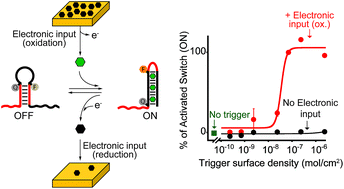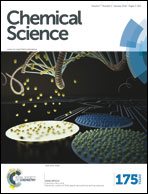Electronic control of DNA-based nanoswitches and nanodevices†
Abstract
Here we demonstrate that we can rationally and finely control the functionality of different DNA-based nanodevices and nanoswitches using electronic inputs. To demonstrate the versatility of our approach we have used here three different model DNA-based nanoswitches triggered by heavy metals and specific DNA sequences and a copper-responsive DNAzyme. To achieve electronic-induced control of these DNA-based nanodevices we have applied different voltage potentials at the surface of an electrode chip. The applied potential promotes an electron-transfer reaction that releases from the electrode surface a molecular input that ultimately triggers the DNA-based nanodevice. The use of electronic inputs as a way to finely activate DNA-based nanodevices appears particularly promising to expand the available toolbox in the field of DNA nanotechnology and to achieve a better hierarchical control of these platforms.


 Please wait while we load your content...
Please wait while we load your content...